Runway Chronicals.📌
Yes, they are chronic, to say the least: a spate of harrowing runway touch ‘n’ throes. It seems airliner takeoffs and landings have been giving rise to an alarming array of airport woes of late, from close calls to flaming calamities. So here’s a jet stream of random runway hazards that cumulatively make for dire, slappy landings:
Close Calls At SFO.
![]() Preliminary reports from the N.T.S.B. reveal how near Air Canada Flight 759 actually came to landing on a taxiway occupied by four aircraft awaiting take-off instructions in July 2018. The Airbus A320 was cleared for approach on an adjacent 28R runway, but instead almost attempted touchdown on a San Francisco International taxiway already clogged with an Airbus 340, Boeing 737 and two 787 Dreamliners. Only a
Preliminary reports from the N.T.S.B. reveal how near Air Canada Flight 759 actually came to landing on a taxiway occupied by four aircraft awaiting take-off instructions in July 2018. The Airbus A320 was cleared for approach on an adjacent 28R runway, but instead almost attempted touchdown on a San Francisco International taxiway already clogged with an Airbus 340, Boeing 737 and two 787 Dreamliners. Only a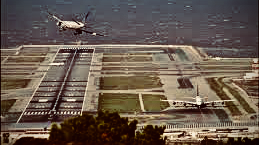 last-second ‘Go around, go around’ cry and captain’s sudden pull-up averted a virtual midnight catastrophe, the Air Canada first officer later claiming that SFO’s confusing landing and construction lights may have caused the A320’s misdirection. The NTSB determined that crew fatigue likely was a factor, and that the first officer’s performance record had not recently met Canadian regulators’ standards for cockpit steadiness and ‘situational awareness’.
last-second ‘Go around, go around’ cry and captain’s sudden pull-up averted a virtual midnight catastrophe, the Air Canada first officer later claiming that SFO’s confusing landing and construction lights may have caused the A320’s misdirection. The NTSB determined that crew fatigue likely was a factor, and that the first officer’s performance record had not recently met Canadian regulators’ standards for cockpit steadiness and ‘situational awareness’.
San Francisco International has since been thoroughly re-certified by the F.A.A. after a safety review of operations, procedures and training. However there are stirrings that last summer’s Air Canada incident was but one of several such SFO runway and taxiway snafus. Now the NTSB has issued revised recommendations on enhanced safety systems, cockpit to ATC towers to runways and taxiways, focusing on pilot warnings to conditions/hazards reporting to clearer airport ground markings.
![]() UPDATE: In the wake of this Air Canada Flight 759’s near miss at SFO, California Rep. Mark DeSaulnier, in consultation with retired Captain Chesley “Sully” Sullenberger (of Hudson River emergency landing fame), has introduced the Safe Landings Act to address the rise in runway close calls and near misses. Runway incursions have increased upwards of 83% over the past six years, endangering more than 1,000 passengers.
UPDATE: In the wake of this Air Canada Flight 759’s near miss at SFO, California Rep. Mark DeSaulnier, in consultation with retired Captain Chesley “Sully” Sullenberger (of Hudson River emergency landing fame), has introduced the Safe Landings Act to address the rise in runway close calls and near misses. Runway incursions have increased upwards of 83% over the past six years, endangering more than 1,000 passengers.
Among the bill’s provisions are for taxiway arrival alarms in airports nationwide. The FAA would be tasked with installing the alert systems, which would advise pilots and air traffic controllers if an incoming plane is not aligned with its runway. The agency would also be required to maintain data and issue guidance on safer instrument landings. Moreover, improvements would be in order to modernize the Notice to Airmen (NOTAM) information system, and have the nation’s General Accountability Office study the reliability of cockpit voice recorders, as well as overall human factors in aviation safety.
This is the first such stab and runway/taxiway safety legislation, and Vamigré will keep the Safe Landings Act’s progress high on our radar screens.
Runaway Runway Delays (September 2019).
![]() Adding to SFO’s runway woes is San Francisco International’s current three-week reconstructing of a key runway intersection. More specifically, a 50+ year-old central stretch of 28L is undergoing the repair and resurfacing of stress and fatigue cracked pavement, laid when airplanes were generally lighter, traffic less heavily used.
Adding to SFO’s runway woes is San Francisco International’s current three-week reconstructing of a key runway intersection. More specifically, a 50+ year-old central stretch of 28L is undergoing the repair and resurfacing of stress and fatigue cracked pavement, laid when airplanes were generally lighter, traffic less heavily used.
The long-scheduled remedial project began September 7, and 28L’s mid-section—SFO’s busiest stretch, crossed by two other runways—will remain closed until the 26th of the month.
So far, SFO flight schedules have been reduced 13%, delays have risen to upwards of 50% to more than 2,000 flights, leaving thousands of passengers stalled, if not utterly stranded. Travelers blame the airlines, carriers blame the FAA, which blames the airport for poor planning, despite a continuous, 24 hour-per-day construction effort.
SFO says it has to complete the ‘vital’ resurfacing before winter rains set it, and has no official sway over how many flights a given airline can schedule. The FAA notes it has little if any authority over how a carrier should handle such an interruption beyond its safety and ATC role. And alternative Northern California airports (San Jose to Sacramento) are offering to help lighten SFO’s congestion. So airlines such as United, American, Alaska and SWA can reschedule and reroute as they please, likely lifting change fees and banishing us passengers to their maddening websites and telephone trees. Thinking about compensatory hotel vouchers, etc.? Don’t sleep on the cold, hard specter of terminal benches and flooring.
As goes this disruptive month, so follows Vamigré, as SFO’s pressures and tensions gain air speed. Actually gaining speed, however, is the runway project itself, which is beginning to help ease the congestion and airlines’ scheduling jujitsu. In fact, it appears the construction crews are completing 28L’s resurfacing a week earlier than scheduled. (MTC…)
Nose to the Ground.
Take that recent ‘no gear, now fear’ touch down at Mandalay airport, as well. A Myanmar Airlines Embraer 190 landed minus a forward gear that had failed to deploy. So the pilots 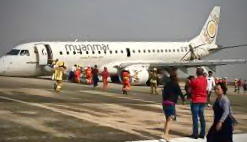 circled twice to burn off fuel and let air traffic controllers see if the forward gear was up or down, then landed solely on the jet’s rear gear, skating down the runway for some 25 seconds before expertly, gently dropping its nose, skidding to an aslant stop.
circled twice to burn off fuel and let air traffic controllers see if the forward gear was up or down, then landed solely on the jet’s rear gear, skating down the runway for some 25 seconds before expertly, gently dropping its nose, skidding to an aslant stop.
No fire, no significant injuries: 89 terrified passengers scrambled out the Embraer’s exits, scurrying toward the tarmac apron shrieking to the heavens, carrying what they could past emergency crews.
Curiously, this was the second Mandalay incident in a week’s time. Just days before, a Bimon Bangladesh Airlines plane slid off the Yangor International Airport runway in inclement weather, minor injuring 17 of its passengers.
Aeroflot Aeroflop.
No such luck in Moscow, where a Russian airliner crash landed and burned not that long before. Over 40 passengers perished in the hard, fiery landing of an Aeroflot SuperJet on a Sheremetyevo Airport runway.
Initial findings suggested that the Sukhoi SSJ Super-100 was struck by lightning some 30 minutes after takeoff on a flight bound for the northern port city of Murmansk. The storm front strike having incapacitated their plane’s communications link with ground towers, pilots flew a brief circular pattern, yet didn’t adequately burn through its fuel load, claiming an inability to ‘maneuver and discard’ it.
on a flight bound for the northern port city of Murmansk. The storm front strike having incapacitated their plane’s communications link with ground towers, pilots flew a brief circular pattern, yet didn’t adequately burn through its fuel load, claiming an inability to ‘maneuver and discard’ it.
Flight SU1492 proceeded to attempt an inordinately high-speed landing on emergency control, as its auto systems were also knocked out. Still carrying that heavy fuel load, the jet’s undercarriage bounced off the runway surface. Officials speculate that fuselage debris shot up into engine cowlings, sparking a blaze and fuel leak that quickly consumed the rear half of the plane in a frightening plume of black smoke.
Some 37 passengers and crew did safely evacuate via front cabin escape chutes, however, far too many dragging along carry-on bags (against emergency protocols). The SuperJet’s black box flight recorders were retrieved once airport teams doused the inferno. But data analysis results may be weeks away.
Meanwhile, the lightning scenario is being clouded with charges instead of pilot error, given the hurried, heavy 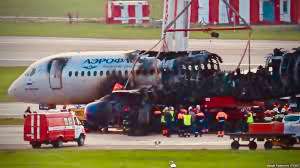 landing. Also questioned are the Super-100’s reliability and safety level; the SU1492 aircraft was relatively new and lightly scheduled. More broadly, this particular SuperJet variant/model did happen to have one demonstration flight crash (into an Indonesian volcano in 2012). Russia’s first post-Soviet designed (circa 2008) plane’s entire fleet was also grounded in 2016 by safety regulators for premature metal fatigue.
landing. Also questioned are the Super-100’s reliability and safety level; the SU1492 aircraft was relatively new and lightly scheduled. More broadly, this particular SuperJet variant/model did happen to have one demonstration flight crash (into an Indonesian volcano in 2012). Russia’s first post-Soviet designed (circa 2008) plane’s entire fleet was also grounded in 2016 by safety regulators for premature metal fatigue.
Still, Russia’s Transport Ministry has found “no design fault” with the plane—even though modern jets are well designed to defy such storms. And it ruled out grounding the Sukhoi Super-100, what with Aeroflot maintaining a fleet of 50 Super-100s, having 100 more on order.
Moreover, of little reassurance on the country’s overall safety commitment was a recording of two unnamed Russian officials joking as they witnessed the fiery landing: “It landed, all right, with a little flame…” Seriously?
Steep Dangers Aloft.
Consider yet another fatal crash at perhaps “the world’s most dangerous airport” in the beautifully hazardous nation of Nepal.
News comes that a pilot recently died as his plane skidded off a runway at 9333 feet above sea level, hitting a parked helicopter and killing two police officers standing nearby. It was the worse mishap there since a 2008 crash that killed 18, including 12 German tourists; two pilots have since been killed in similar accidents therein. Just this past February, a tour copter wreck killed seven, not least Nepal’s Minister of Culture, Tourism & Civil Aviation.
The truncated runway of Lukla Airport sits at the edge of nearly a half-mile drop, surrounded by the 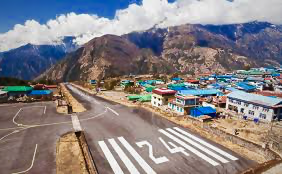 Everest Region’s famous mountains, buffeted by strong cross winds, making for uniquely treacherous takeoffs and landings.
Everest Region’s famous mountains, buffeted by strong cross winds, making for uniquely treacherous takeoffs and landings.
Both plane and chopper (owned by the same company) regularly airlifted climbers and tourists up to the soaring mountain peaks—a service that has grown dramatically to meet the demand of ever increasing traveler/tourist arrivals and departures.
Despite Nepal’s pilot licensing requirement of 100 takeoffs and landings on short runways under these tough conditions, the country is dogged by a sketchy safety record. The European Union has even banned all Nepalese flights in EU airspace. Still, chances are this crash will hardly dent the burgeoning Everest T/T trade.
Hairy O’Hare Incursions.
In recent years, Chicago’s ORD, once ‘the nation’s busiest airport’ has suffered a rash of runway and taxiway incidents that have challenged, if not threatened the Windy City’s ranking for commercial flight safety. That status has been jealously maintained since 1979’s infamous American Airlines’ Flight 191 DC-10-10 disaster, killing 273 in all, still the most deadly passenger airline accident on U.S. soil.
The former Air Force base cum sprawling airline hub has been averaging 20-some serious runway 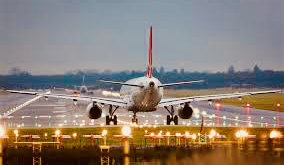 incursions per annum (over 60 in the past 2.5 years). Worrisome enough are reports of planes mistakenly taxiing onto ‘live’ runways, or wrongly landing on strips already allocated to jetliners revving for takeoff.
incursions per annum (over 60 in the past 2.5 years). Worrisome enough are reports of planes mistakenly taxiing onto ‘live’ runways, or wrongly landing on strips already allocated to jetliners revving for takeoff.
Such blunders have set off anti-collision alarms and precipitated the issuance of ‘go-around instructions’ from the air traffic control towers, directing approaching aircraft, even those merely a mile or so from landing, to circle around (or stack, when necessary) until runways are cleared.
But creating further tarmac hazards are ground crews routinely crisscrossing (sometimes stalling upon) O’Hare’s labyrinth taxiways and runways that are active with takeoffs and landings. This includes airport and city vehicles for everything from maintenance/tradesmen to lawnmowers.
Yet these safety infractions rarely result in commensurate disciplinary action by either the Chicago Department of Aviation or FAA.
You Shan’t Take It With You.
In any case, this little bit of in-cabin wisdom issues forth from the FAA and NTSB: When disaster strikes, should your aircraft hit ground (and/or catch fire), keep your wits in check and follow the crew’s emergency instructions to 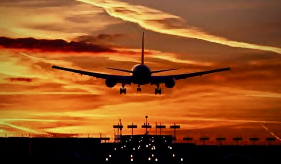 evacuate as quickly and orderly as can be. But for godsakes, leave your carry-ons behind.
evacuate as quickly and orderly as can be. But for godsakes, leave your carry-ons behind.
Beyond that, when it comes to runway safety, Vamigré will keep a steady eye on these dicey sites and skies along the way, as well as any/all enhancements and advancements. Simply put, we will continue to chronicle the chronicals. (MTC…)
